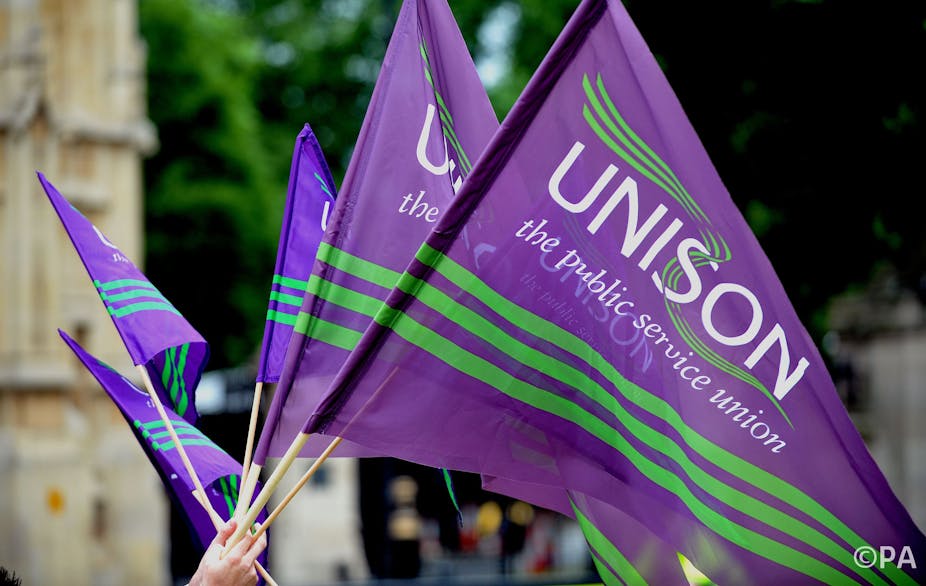As the trade unions embark on another co-ordinated day of action they could soon be embroiled in another battle. The government is adopting a harder line through plans to bolster the law on industrial action ballots in what they deem to be “essential services”.
If the government gets its way, there will need to be a minimum turnout in the ballot for action to be lawful, and ballots would have a limited period of validity.
What is surprising is the timing of the announcement. Could it be this is the start of the Conservative election campaign proper? Is it an attempt to attract the voters who have shifted their allegiance, albeit temporarily, to UKIP?
Low turnouts
It might be argued the public sector unions have brought this upon themselves by calling a series of strikes based on ballots with low turnouts. In an opinion column in The Times as far back as November 2011, I questioned the legitimacy of industrial action called after low-turnout ballots.
Over the past three years or so a number of public sector strikes have been called after ballots with turnouts of below 40%. In 2011 Unison achieved a turnout of just 29% when it took action over pension reforms. Earlier this year the turnout in the PCS ballot was 28% and a series of strikes by the RMT on the London Underground were held after votes with similar low turnouts. This is in stark contrast to the British Airways cabin crew strike which saw turnouts of 80%.
The stumbling block for the government is the classification of what is an essential service. This is not something that can be plucked from the air for convenience. The main guide as to what is services are essential is defined by the ILO Principles Concerning the Right to Strike as services where: “the interruption of which would endanger the life, personal safety or health of the whole or part of the population”.
In the strict sense essential services are defined as “the hospital sector, electricity services, water supply services, the telephone service, air traffic control”. They don’t include education or general or metropolitan transport, but probably would include the fire and rescue service.
Minimum thresholds
For many months I have been predicting the Conservatives will change the law on strikes by requiring minimum thresholds participating in ballots. In Early May, speaking in Stroud, Gloucestershire, David Cameron suggested this “could” be in the party’s next election manifesto. Now, after announcements this week by by the prime minister and Frances Maude, we know it will be. The prime minister is thought to favour Boris Johnson’s proposal that at least 50% of those entitled to vote do so over the CBI’s call for a 40% threshold.
Requiring a minimum turnout in a ballot of 40% or 50% may not go far enough for Cameron and Maude, hence the lack of detail at this stage. I believe they will consider a more radical stance. Let’s assume that 51% of members do participate in a ballot and there is 51% majority in favour of action, this still means that just over a quarter of the affected workforce support industrial action and the majority don’t.
The manifesto could well contain more stringent requirements; it is not inconceivable they will require a majority of those entitled to vote to support industrial action. That’s a different thing altogether and for many unions it would make industrial action virtually impossible. There are some who might consider this a good thing, but it would remove the strike as a legitimate “last-resort” safety valve.
Time limit
Introducing ballot validity periods should come as no surprise either. Although for a strike to be lawful the first day of action must take place within 28 days of the ballot, once this criterion is satisfied the ballot is valid without a time limit. There were many complaints about members of the NUT taking strike action based on ballot results over two years old. Although they did nothing wrong legally, there is a moral argument to be made – and this will not have gone unnoticed by the government.
There is no doubt the unions have a problem in getting decent turnouts in industrial action ballots and, as a result, open themselves up to criticism. Turnouts of 20, 30 or 40% can hardly be considered a mandate for action. If they are to overcome the thresholds that are likely to be introduced, they need to find ways of mobilising the apathetic membership.
These proposals could be the stimulus the unions need to do that. If participation in ballots increases to the required level, any action that results must be considered legitimate. I’m not sure how the government or employers would deal with that.

